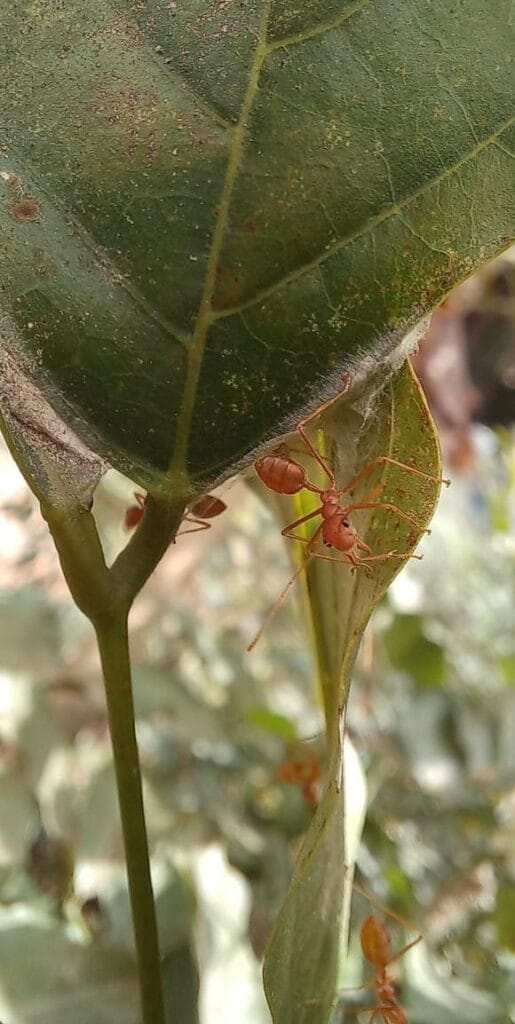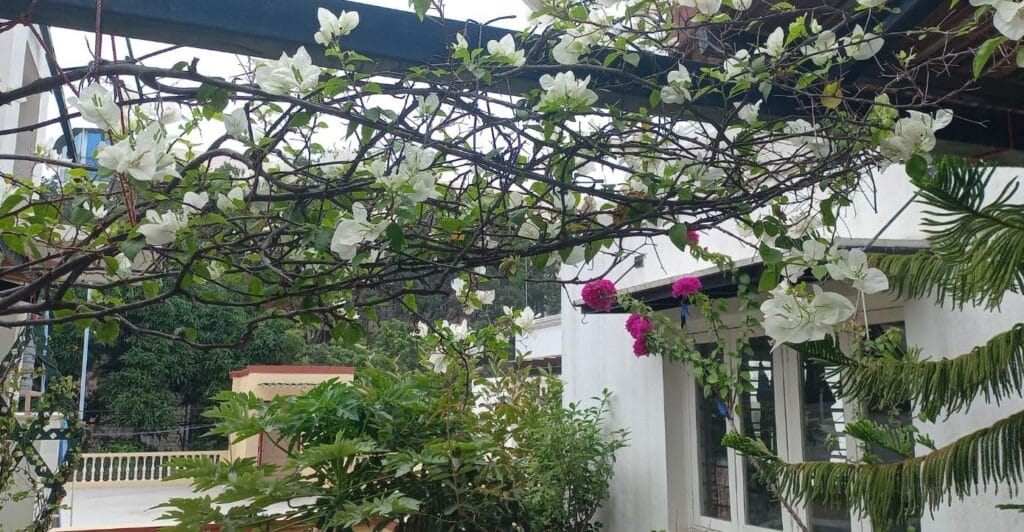Part 1: More insects than we cared to get acquainted with…
Both as an architect and heritage conservation expert, ecological living has been a day-to-day mantra for me. However, it’s not without its attendant perils as many years of living in a home in the city, built with natural materials, has demonstrated. Our woeful tales of insects and other species reluctantly permitting us to share space with them, provide much amusement to friends and family. And now, I have decided to spread the joy and share some of our encounters with a wider audience.
We blithely commenced our home construction project over 15 years ago. As much as possible, we wanted to use natural materials. After much negotiation and compromise we decided on brick walls, a partly double-tiled roof and partly hollow, clay block vault; Chappadi stone lintels and Cuddapah ceilings with no RCC, plaster, patti or paint on the ceilings; and black slate flooring with no hint of a vitrified tile anywhere. If only we knew better!
The home invasion started small — it always does! A few tiny black ants on the kitchen counter, then slightly larger ants on the floor, which eventually became multiple colonies of God’s various creatures — behind doors, tiles, walls and the hot-water geyser, in our cane curtain rods, the terrace garden. Everywhere.
Read more: Why Kolkata’s post-cyclone reforestation spree has failed to cheer environmentalists
You name the species and we have either hosted them or continue to host them: black ants, weaver ants, fire ants, innumerable unidentified species of spiders ranging from small to ginormous (slight exaggeration here), potter wasps, mud daubers, paper wasps, solitary and honey bees, (what we thought were) bumblebees, hornets, praying mantises, beetles and caterpillars. Also, the periodic bat, frog, mouse, rat, squirrel and other resident insect-eating creatures, including various lizards. We didn’t always know how to identify the various species; the learning came alongside the multi-species home invasion.
The invasion of the ant armies

Lesson learnt: Don’t waste time and energy in ant-proofing your home, learn to live with them and around them!
It was about a week since we moved into our home when I noticed a few tiny black ants on the kitchen counter. I painstakingly checked for crevices, gaps and holes, no matter how tiny, which they could have crawled through, but no luck. I didn’t want to use chemicals, so I looked up natural ways of ridding one’s home of ants but nothing worked. I decided to just let them be, for what could a few ants do?
We did have to teach our toddler daughter that ants were not fun squash toys but living beings to be left alone. As I began to devote more time and energy to raising a garden on our terrace, I realised just where they were coming from. The planters were not so much soil and nutrients for my saplings as they were ready-to-move-in homes for ants — cool, moist with ample room for multiple ant ‘galaxies.’
Every planting season involved much labour, especially in the case of the large planter tubs; carefully emptying the tub of all soil, removing the ant colonies, putting in fresh soil and hoping for the best.
Why do I keep trying, you ask? When it came to the plants I had nurtured or ants I had not invited, the choice was clear. But they have worn me down. It has now reached a stage where I know their favoured seasonal homes through the tell-tale signs of fine piles of red mud next to the drainage holes of select planters. And I have learnt to leave them alone while saying a prayer for the December flowers and Hibiscuses in those tubs, as they continue to battle for shared resources.
Efforts to save a magnificent tree

The plot next door remains unbuilt. In between bouts of wildly imagining that someday we would be able to afford to buy it, raise a garden there, and let our dogs roam freely, I have made numerous attempts to grow shrubs, herbs, and the occasional tree in this plot with mixed results.
I watched a magnificent kodukapuli grow to the height of a two-storeyed house and witnessed bulbuls, tailorbirds, sunbirds, koels and the occasional sparrow-hawk make it home. Lines of crazy ants — yes that’s a species, I didn’t make that name up — and other ant species, including carpenter ants, would walk on ropeways of tangled internet cables to commute between this tree and the social forestry trees in front of our plot.
Read more: Reprieve for Chevella Banyans: What it tells others fighting for roadside trees
My daughter learned to identify a few bird species thanks to this tree. But, one fine day the tree that took nearly 8–10 years to grow was pulled down in a matter of minutes, with an earth mover. I still don’t know why! The Pongamia I had planted along the edge was spared, maybe because it was still a sapling at that point or because I objected to the kodukapuli being pulled down. What I didn’t realize then was that the Pongamia would become a favoured abode of weaver ants and an elevated highway for fire ants.
The tree is located beside the staircase leading to our terrace and one needs to tread warily to not disturb the weaver ant nests in it to avoid painful bites. However, the perils of being bitten and sprayed with formic acid remain preferable, compared to the piles of garbage and trash that inevitably and stealthily find their way into this plot. All this, despite our polite requests not to litter and the innumerable times we pay to have the plot cleaned.
Currently, the bi-annual pruning of branches that now overhang our staircase is an operation involving much stealth. The objective is to not disturb the weaver ant nests hanging overhead and the possible fire ant highways till the nth second, and then immediately abandoning the site of branch-fall for many hours till the ants have clambered over the wall, back to the safety of the tree.
Having seen my husband batting off ants that clung tenaciously to his legs, feet, shoulders, neck and arms, resulting in multiple painful bites, I no longer trust anyone but myself to carry out this stealth operation.